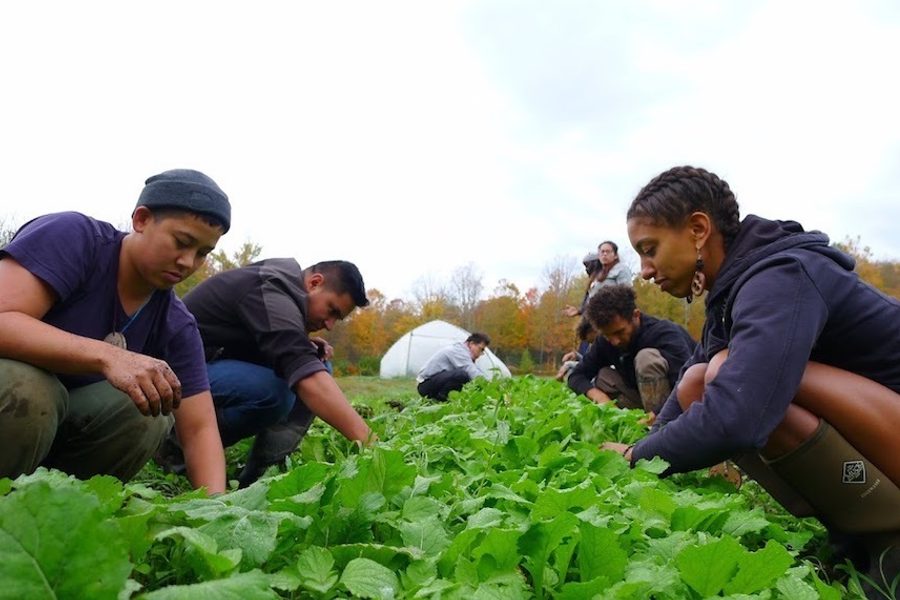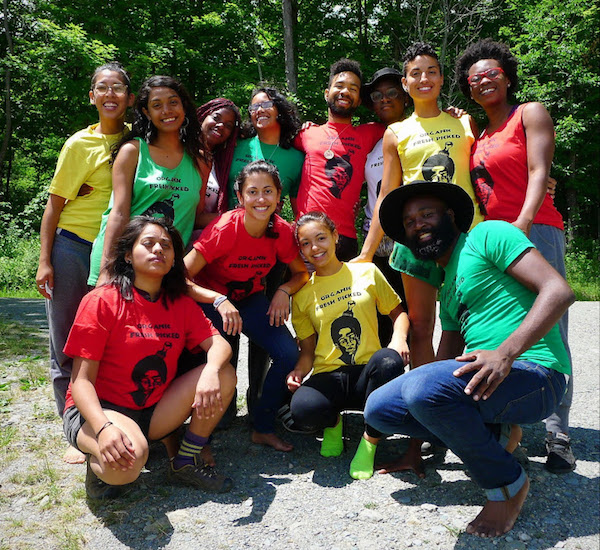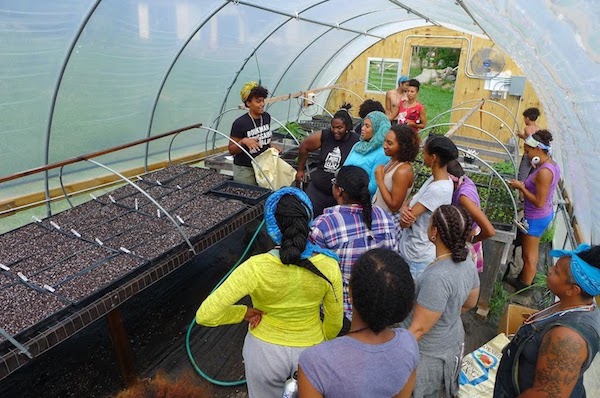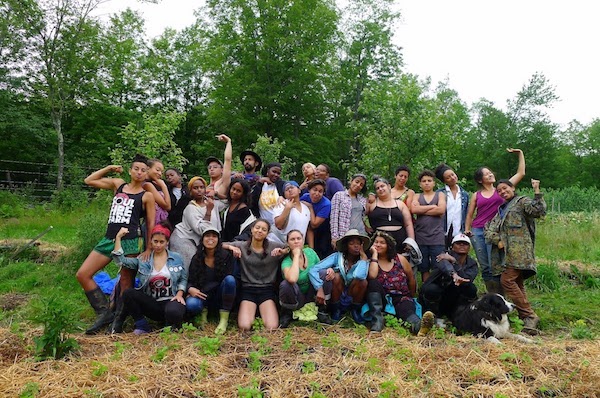An Agricultural Movement for People-to-People Reparations Puts Itself on the Map
Emeline Posner

On a small plot of land on the outskirts of Chicago, a farm collectively owned by gender-non-conforming immigrants will cultivate produce and a younger generation of food justice activists. That’s the vision that Viviana Moreno, Nadia Sol Ireri Unzueta Carrasco and Jazmín Martinez, organizers and farmers based in Chicago’s Little Village neighborhood, are working to turn into reality.
Catatumbo Collective, as the three call themselves, told Rural America In These Times in an email: “We’re approaching a worker-owned farm through an intersectional and holistic lens that understands that our community’s issues can be addressed in part by sustainable farming and food justice educational programs.”
Viviana, Ireri and Jazmín have known each other from years of organizing against deportations in Chicago and working in Little Village’s Semillas de Justicia community garden.
Of Venezuelan and Mexican heritage, the three incorporate their families’ experiences — with land stewardship and NAFTA-driven migration — and the history of campesinos’ and Indigenous peoples’ land struggles into their approach.
As they got more involved with Chicago’s urban agriculture movement, Ireri found few resources that provided the needed historical or cultural context. “History of the land, history of the exploitation and abuse of people working the land, and the history of resistance and resilience by Indigenous people and people of color,” Ireri says, was lacking.
They found a resource in Soul Fire Farm, a people-of-color-led farm and educational center based in Grafton, N.Y. Last summer, they all attended Soul Fire’s Black and Latinx Farmer Immersion, a program designed to impart ecologically-restorative farming techniques to people of color and to foster conversation about racism, and racial justice, in the food system.
At Soul Fire, co-founders Leah Penniman and Jonah Vitale-Wolff “gave us the space to come together, look at each other and realize [that] we are who we have been waiting for,” Viviana says. “Our individual stories and histories had already brought us together and Soul Fire solidified our commitment to land justice and reparations.”
Catatumbo is part of an international, decades-old movement for food sovereignty. Coined by international farmer coalition Via Campesina in 1996, “food sovereignty” is the idea that food production and distribution should be controlled by workers, not by powerful, profit-driven corporations. Now, organizations like Soul Fire, Catatumbo and other groups of farmers of color are building a racial justice aspect into that framework, and are looking to uplift Black, Brown, Indigenous, and immigrant farmers — those who have borne the brunt of labor exploitation, land theft and discriminatory agricultural policy — all the while advocating for ecological farming practices and racial healing.
At Soul Fire Farm, one of the food sovereignty movement’s several hubs, immersion programs have been supporting Black and Brown farmers across the United States and highlighting their history. Now, a younger generation of Soul Fire alums — like Catatumbo Collective — are putting themselves on the map.

Building Black and Brown farms through reparations
After attending the Black and Latinx Farmer Immersion Program, Viviana, Ireri and Jazmín left with the confidence to commit to forming Catatumbo Collective. But while they were there, they started a conversation that would lead to the online reparations map that Soul Fire launched earlier this year.
“[Work toward reparations] has been happening for a couple of years, but as far as the official map that was just launched, that came out of Viviana’s work,” Penniman tells Rural America In These Times. “We were talking about … reparations gifts, and she just said, ‘We need to spread this and have more people-to-people solidarity.’ And so we made it happen!”
The map, which has attracted nearly 45,000 views to date, lists 44 farmers of color and their specific needs, which range from equipment and seeds to funding, land access and legal advice.
At Perspektive Farms in rural Pennsylvania, a Black family of tree farmers are looking for funding to build a greenhouse. In New Jersey and in Alabama, organizers are looking for the funds to start an Indigenous farming collective and an Indigenous-led ecovillage, respectively. Outside a wildlife refuge on the island of Honolulu, the Four Women Radicals farm is looking for 5 acres of land to start a community farm dedicated to educating Black and Brown women on sustaining themselves.
As a tool for a grassroots movement, the map is specifically designed to facilitate people-to-people donations. The location of each farm and project is denoted by a pin. When viewers click on a pin, a sidebar pops up with information about that specific farmer’s vision and needs. It also provides the farmer’s contact information, so that the viewer can get in touch if they are interested in making a contribution.
Already, some of the tens of thousands of clicks have led to funding for several farmers’ projects. From one donor, Dallas Robinson received $7,000, which she’ll use toward the purchase of a tractor and the construction of a cool room for produce storage. With that gift, she’ll be on track to open her herb and mushroom farm, the Harriet Tubman Freedom Farm, in Red Oak, N.C. in early 2019.
Another reparations map victory came recently to Jahshana Olivierre, a community builder in Canarsie, N.Y., who received $2,800 through the reparations map—enough to fund an apothecary apprenticeship, which will help her build knowledge to start her own youth-led herbal apothecary and cooperative.
These reparations victories follow earlier gifts that originated from a different Soul Fire program, Uprooting Racism in the Food System Immersion. The program offers training for people who have positional privilege in the food system and want to learn how to avoid being complicit with white supremacy in their day-to-day work.
Two Black- and Brown-led farms in central New York, Harmony Farm, in Goshen, N.Y., and Wild Seed Community Farm, in Millerton, N.Y., were created through gifts of land and funding by alums of the Uprooting Racism program.
“There’s an awakening consciousness that reparations are necessary and aren’t seen as some fringe unreasonable demand, but really an essential part of racial healing,” says Penniman.
Institutional reparations — such as the 1999 Pigford v. Glickmanclass action discrimination suit that won $1.25 billion for Black farmers denied loans and assistance by the USDA — are necessary, Penniman says. But she points out that the average payout was $50,000 per farmer, “which is not enough to get a good tractor, let alone get your land back.”
According to a paper in the Southern Rural Sociology journal, as of 2002 Black-owned or -operated farms numbered less than 20,000 and tending a total of 2 million acres — a decrease from the 1920 peak of 926,000 farms on 16 million acres.
“We absolutely do need to continue to litigate, and to do that policy work, but we don’t have to wait for that to enact reparations,” Penniman says. “We can actually start right away with these people-to-people transfers, of wealth that was stolen, to the people from whom it was stolen.”
Getting farmers of color on the map
Catatumbo Collective’s primary goal for the map was to help facilitate these transfers of wealth. But, incidentally, the map may also help towards building up an online database of farmers of color, who have long been underrepresented by demographic surveys.
While government-led surveys are likely to underrepresent small-scale and Black and Brown-operated farms, independent surveys are no more likely to have accurate counts, as Nathan Rosenberg and Clay H. East recently argued in the New Food Economy.
For example, the Washington Post and other outlets share uplifting stories of how the youngest cohort of farmers is defined by its dedication to sustainable techniques and its diversity — but they draw on a National Young Farmer Coalition survey that skews toward “highly educated, ex-urban, first-time farmers,” a group that is unrepresentative of the full spread of farmers under 35.

In reality, the number of young farmers of color is likely higher than the current USDA estimate, though by how much is unclear.
One reason for this discrepancy in narrative is that the USDA has long failed to account for small-scale farms in its census. (As of 2002, Black farmers were likely to operate less than 50 acres of farmland, far below the national average of 440.) Although the USDA has been working to improve its methodology since 1997, its counts are likely still too low, given how small farms are decreasing in number at the same time as “very small” farms and gardens are increasing. By their very nature, very small farms and gardens, whether in rural or urban areas, are difficult to track from year to year.
Independent and grassroots maps like Soul Fire’s reparations map will not serve as a replacement for more comprehensive surveys, but farmers like Penniman and the Catatumbo members see it as a step in the right direction. In the meantime, it serves the more important function of helping people of color and allies locate, and support Black and Brown farms.
“We do need a directory of POC-run farms and health centers. This map may or may not be the thing, but it has been a long time call-out that we have needed in our movement,” Penniman says, adding a shout-out to Tasha Bowens, who published a book called the Color of Food, which maps out farm projects run by people of color. “But I do think that we need a curated space, a vetted space, that says these are the farms that are legit run by people of color that legit exist, and this is what they offer.”
In the meantime, the map’s creators are hoping to expand the breadth of the map, which currently skews heavily toward the Northeast, where they’ve built their network. “That is not where most of the Black farmers are,” says Penniman, “They’re in the South, and in the West. But I am really excited for it to grow. This project is just one humble and small piece of that overall movement for Black land sovereignty.”
Catatumbo’s beacon for food justice
The Catatumbo River, from which the agricultural collective pulls its name, flows from Colombia down into Venezuela. For around two-thirds of the year, and for as many as 10 hours a night, lightning storms linger over the mouth of the Catatumbo River, where it empties into Lake Maracaibo. The sharp bursts of lightning that the storms generate are so bright that they have functioned as a “natural lighthouse” for generations of sailors.
It’s a striking name for the farm collective that the three Chicagoans envision building, both in the interest of cultivating ecologically and teaching younger members of their communities to do the same. But it won’t be built overnight: Catatumbo hasn’t yet received reparations. To start, they need assistance finding a plot of land, a truck and guidance on how to form a business as residents of mixed documentation status. Through the map that they helped to create, they’ve received numerous messages and offers of assistance, but most of those offers have not materialized. None of them denies that it’s a long road forward to their peri-urban farm, but it’s one they’re committed to following.
In the meantime, the voices behind Catatumbo are helping to shape the conversation around urban agriculture and food justice in Chicago. At a February 2018 Chicago food policy summit, a breakout session on Black and Latinx agricultural history, which Viviana helped to lead, pulled half the summit’s attendees. And until they fund their farm, you can find Viviana, Jazmín and Ireri in Chicago, organizing, teaching, and using the gardens they do have to grow and to impart their knowledge about stewardship to others.








